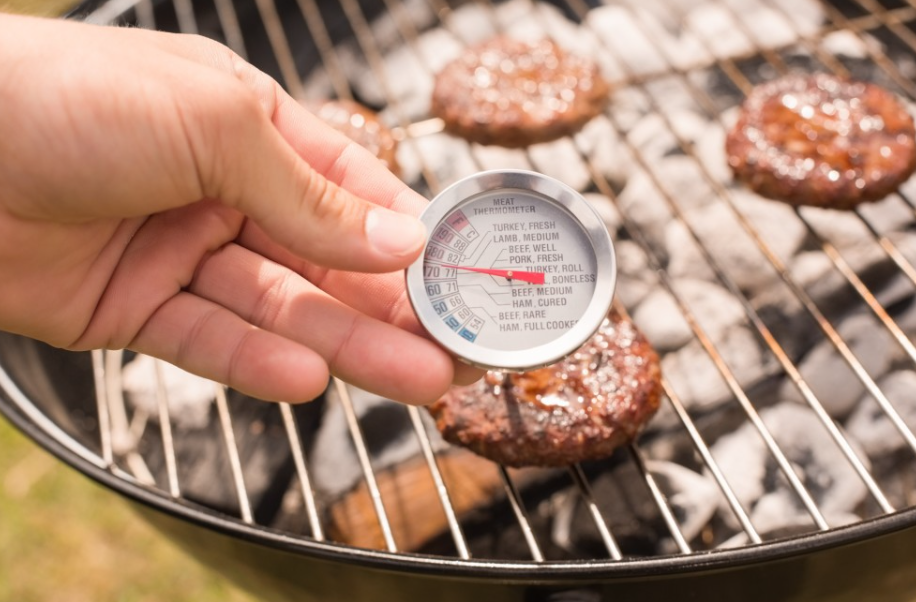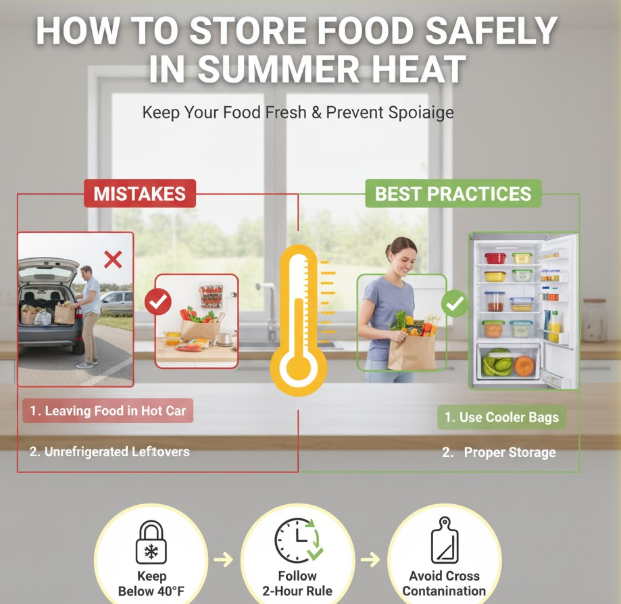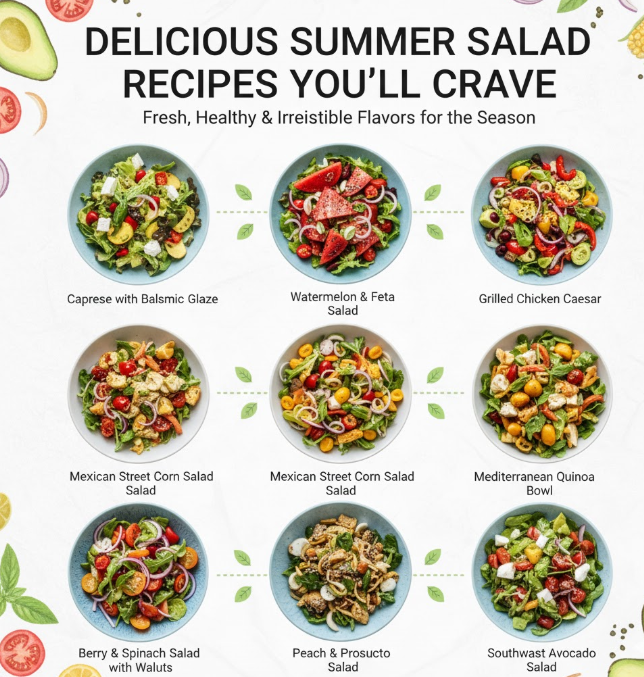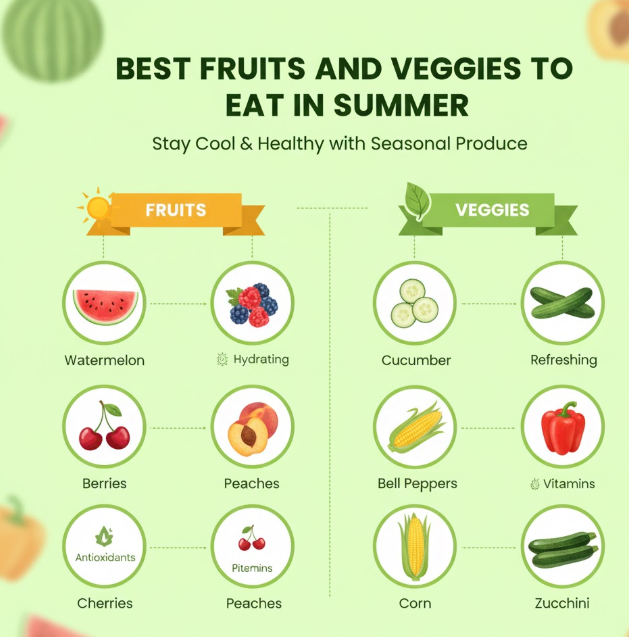Summer means sunshine, beach excursions and backyard barbecues. It also introduces something less cool: heat that can make your kitchen a hazardous environment for food. When the heat index is high, bacteria multiply faster than you can say “food poisoning.” One minute that potato salad is fine, and the next it’s a hotbed of nasty germs that might make you really sick.
All too often, they don’t know how to protect their food from summer heat, and thousands of Americans get stomach bugs, nausea and worse. The good news? You don’t have to rush out and buy fancy equipment or get a science degree, however, to ensure that your food is safe. All you need is a few simple principles to follow and practice.
This guide should teach you everything you need to know about storing food safely when the mercury is soaring. Whether you’re packing a picnic, stocking your fridge or throwing a cookout you’ll pick up useful tips that are easy and actually work. We’ll tell you which foods are most at risk, how long various items can sit outside and creative workarounds to keep your food fresh and safe. You’ll end the summer freed from guilt over whether that chicken sandwich has been out too long.
Why Is Summer Heat Bad for My Food?
Bacteria enjoy heat as much as we do — and maybe more. By the time it cools to a still-above-room-temperature 140°F, everything is good to go for any bacteria that was present before cooling — or picked up between when you removed your pizza and when bacteria attempts were made to analyze it. When temperatures are within that Goldilocks range 40°F and 140°F (what food safety experts call the “danger zone”), some kinds of bacteria can double in number every twenty minutes. That’s not a typo. A single bacterial cell can be millions in two hours.
Imagine what happens when you leave groceries in a hot car for 30 minutes. Or when your picnic bakes in the sun at lunch. Or when it’s a scorching afternoon and the power goes out. In each case, bad bacteria — think Salmonella, E. coli, Listeria — are partying in your food and making toxins that can make you very sick.
Summer heat is not just bad for meat and dairy. Even fruits, vegetables and cooked grains can become contaminated with bacteria if they are stored improperly. There are even differing guidelines for the best storage options depending on how hot it gets outside: The warmer it is, the quicker your food spoils, which means the less “safe time” you have and the more vigilantly you have to play this gross little game.
Crucial Rules Anyone Should Follow
Before diving into particular foods and storage methods, here are the non-negotiable rules that apply to all of them:
Two-Hour Rule (or One-Hour Rule)
No food should be left out at room temperature for more than two hours. In other words, when the temperature outdoors is in excess of 90°F, there’s only a one-hour window. After that, levels of bacteria can multiply to unsafe levels even if food looks and smells OK.
This goes for cooked food, sliced fruit, opened packages and anything else that would need to be refrigerated. Set a timer on your phone if you have to. Better to toss the food than spend the next day with your face in the toilet.
Keep Cold Foods Cold, Hot Foods Hot
Cold foods need to be kept at 40°F or below. Hot foods should remain at 140°F or hotter. There’s no middle ground here. If you cannot control these temperatures, don’t take a chance.
When in Doubt, Throw It Out
Your nose isn’t always reliable. Dangerous bacteria can lurk in food that doesn’t appear, smell or taste bad. If you have any doubt that something has been stored safely, don’t take chances. Your health is more valuable than the remnants of a sandwich.
How to Organize Your Fridge and Freezer in the Heat of the Summer
Your refrigerator is already operating in overdrive during the summertime, and you want to do everything necessary to make sure it can do so efficiently.
Set the Right Temperature
Your refrigerator should be 40°F or colder, and your freezer zero or lower. Purchase a refrigerator thermometer (it’s about five dollars) and monitor it consistently. The analog built-in temperature displays are sometimes not very accurate.
Don’t Overload Your Fridge
Cold air must circulate for everything to stay properly chilled. When it gets crammed too full, some things will not get cold enough. If you’re throwing a party or making huge grocery runs, think about renting a cooler with ice packs for extra items that won’t fit in your normal cooler.
Keep the Door Closed
When you open the fridge door, warm air clamors in. It’s an even bigger problem during summer, when your kitchen is already hot. Think ahead for anything you’d like to pick up in a single trip, if possible.
Strategic Placement Matters
The rear of the refrigerator is generally the coldest, so put highly perishable things like raw meats there. The door is the warmest — don’t store milk or eggs there (even if many drawers have special egg holders). Designate door shelves for condiments and drinks only.
How to Handle a Blackout
Summer storms can cause the power to go down when your fridge is running at full capacity. If the power goes out, keep the doors to your refrigerator and freezer closed. A freezer that is completely full can safely keep food at the proper temperature for 48 hours without electricity, according to the U.S.D.A.’s Food Safety and Inspection Service; if it is half-full, 24 hours. If you don’t open it, you can reasonably get 4 hours of cold-keeping out of a fridge.
Safe Storage Length for Popular Summer Foods
Not all foods have the same storage needs. Here’s a detailed breakdown:
| Food | Refrigerator (40°F or below) | Freezer (0°F or below) | Room Temp Limit |
|---|---|---|---|
| Fresh raw chicken | 1-2 days | 9 months | 1 hour (over 90°F) |
| Fresh raw beef/pork | 3-5 days | 4-12 months | 1 hour (over 90°F) |
| Cooked meat dishes | 3-4 days | 2-3 months | 1 hour (over 90°F) |
| Potato/pasta salad | 3-5 days | Not recommended | 1 hour (over 90°F) |
| Cut watermelon | 3-5 days | 10-12 months | 1 hour (over 90°F) |
| Hard-boiled eggs | 1 week | Not recommended | 1 hour (over 90°F) |
| Opened deli meat | 3-5 days | 1 month | Varies |
| Dairy products (milk, yogurt) | 7 days after opening | Varies | Varies |
Meat, Poultry, and Seafood
These are summer’s most dangerous foods. Raw meat should be placed directly in your fridge or freezer when you return home from the store. If you purchase meat on a hot day, take along a cooler in your car with ice packs.
Never thaw meat on the counter. Use the refrigerator (prepare ahead — it will take time), cold water (change the water every 30 minutes) or microwave oven if you are cooking immediately. Meat that has been defrosted and spent time in the danger zone should not be refrozen.
When you have cooked meat that needs to chill for a bit before hitting the fridge, it needn’t cool at room temperature. Divide into shallow containers to let them cool more quickly, and refrigerate within two hours (one hour if it’s over 90°F outside).
Dairy Products
We depend on good refrigeration and all the things like milk, cheese, yogurt, butter that go with it. That also means no lingering during breakfast and hanging around after dinner. Pour what you want and place the container right back.
Fact: Soft cheeses (say, brie or feta) are more susceptible than hard cheese. When you’re having a party and there’s cheese set out on the table, put just a little bit out at once, replenishing from the fridge as needed.
Eggs and Foods Containing Eggs
Raw eggs in the shell will last in the fridge for 3-5 weeks, but once you beat, scramble or whisk them those eggy dishes are far more perishable. They should be refrigerated within the hour on hot days.
Hard-boiled eggs are the perfect summer snack, but they spoil more quickly than raw ones. Store in the refrigerator and use within a week.
Fruits and Vegetables
Whole fruits and vegetables are typically safe at room temperature, but when you cut into them, different rules apply. Fruit that is cut gives bacteria plenty of room to grow. On hot days, refrigerate cut fruit within an hour.
Here are a few fruits and vegetables that require refrigeration even when you haven’t cut or sliced them:
- Berries
- Leafy greens
- Cut vegetables
Tomatoes and bananas do best at room temperature until they are cut.

Cooked Leftovers
Yes, this is also valid for leftover pizza, pasta, rice and casseroles: Refrigerate within two hours (one hour if above 90°F), and eat in three to four days. Cooked rice is particularly risky as bacteria on the grains can multiply, leaving heat-resistant toxins behind.
Picnics, Barbecues, and Outdoor Eating
Dining alfresco is a summer staple — and also where food safety slipups occur most frequently.
Cooler Strategies That Actually Work
Have separate coolers for drinks and food. The drink cooler is opened and closed all the time, between cans of soda, allowing warm air in. Keep your food cooler closed as much as you can.
Fill coolers with ice or frozen gel packs. Two pounds of ice for every pound of food is recommended. Block ice takes a bit longer to melt than cubed ice. Freeze water bottles and use them to keep your cooler cool; as they melt, you’ll have cold water to drink.
Place coolers in the shade, and cover them with a blanket or tarp for additional insulation. Never leave coolers in the car.
Food Prep for Outdoor Events
Prep the meat at home and finish it on the grill. This means raw meat spends less time in the danger zone. You can marinate meats (in the refrigerator, never on the counter).
Bring food in small batches. Don’t set out all the food at once; instead, keep backup portions in your cooler and refill as necessary. This prevents food from sitting out at an unhealthy temperature and helps to cut waste.
When cooking meat, always use a food thermometer. Hamburgers at 160°F, chicken at 165°F and steaks at a minimum of 145°F (the USDA says rare beef can be cooked to 135°F but that is as low as it goes). Color is not a good indicator of doneness.
For more detailed guidelines on safe minimum cooking temperatures, visit the USDA Food Safety website.
The Buffer Zone Technique
Establish a no-go zone for hot and cold foods. Do not place the cooler next to the grill. Keep cold salads away from hot surfaces. To help food stay cold for a longer period, use ice baths or cold packs under serving dishes.
Shopping Tips for Hot Weather Shopping and Transportation
Food safety begins before you leave to go home from the store.
Smart Shopping Strategies
If you’re running multiple errands, get groceries last. Your hot car can be deadly for perishable items.
Add frozen foods to your cart last while shopping. First grab produce, then canned goods and finally frozen and refrigerated items right before checkout.
Bring reusable insulated bags or a cooler for the ride home. Some stores even have ice to keep food cold.
Getting Food Home Safely
On hot days, go directly home from the grocery store. Don’t make any coffee stops or other very brief errands where perishable food is in the car.
If you have to stop, bring a cooler and move any of your cold items into it. Your car can warm up to 120°F or more in the summer sun — hotter than it would have to be in order to cook food, not just spoil it.
When you arrive home, unpack any perishables first. Bread and chips can hold; meat, dairy and frozen items cannot.
Worst Summer Food Offenders
Certain foods pose more risk than others if they aren’t stored correctly during hot weather.
Mayonnaise-Based Salads
Summer food poisoning staples such as potato salad, coleslaw and chicken salad can all contain bacteria. What with the protein and starch and mayo, it’s like a bacteria factory. These should be kept refrigerated up until the last moment and stored within one hour.
Deli Meats and Cheese Trays
Pre-sliced deli meat harbors bacteria far more quickly than whole cuts because there’s more surface area available. Variety cheese trays can also be a problem because different cheeses come with different safety profiles.
Anything with Raw Eggs
Salmonella can lurk in homemade ice cream, raw cookie dough, Caesar dressing and hollandaise sauce — that’s because these products are often made with raw (unpasteurized) eggs. These are products that require extra attention in the summer heat.
Rice and Pasta Dishes
Cooked rice is a known source of Bacillus cereus, bacteria that flourish at warm (or room-temperature) conditions and produce toxins not easily destroyed by reheating. Always refrigerate rice dishes after one hour at room temperature.
Special Considerations for Different Situations
Camping and Extended Outdoor Trips
Freeze meat before camping trips. Frozen meat doubles as added ice, and will thaw in the cooler over a day or two. Pack in reverse order of when you’ll need to use items — dinner for the last night goes in first.
Consider a combination of regular coolers and dry ice, if you will be gone more than a couple of days. Dry ice can help maintain frozen food 3-4 days, but you should handle it cautiously (use gloves and place it in an open ventilated container).
Tailgating and Sporting Events
Games have an earlier time and food sits out longer. Divide things up into smaller containers and keep most of the food in the cooler, only taking out what you’ll need for the next hour.
Don’t carry high-risk foods at all-day events. Choose foods that won’t go bad or that can withstand heat better, such as whole fruits, nuts and commercially packaged snacks.
Beach Days
Beach foods are especially challenging when it comes to food safety — sand and sun! Bury your cooler in the sand, preferably in a shady area — it’ll help insulate it. Never leave coolers or food bags in direct sunlight.
Bring hand sanitizer or wipes, because you won’t have soap and water. Clean hands are vital when preparing food.
Technology and Tools That Help
Food Thermometers
A digital instant-read thermometer is entirely essential. For a good one, they’re cheap (likely under $20), and they take the guesswork out of whether or not your food is safe. Put it to work for cooking meat, heating up leftovers and even checking your refrigerator temperature.
Smart Storage Containers
Spend some extra money on good sealable containers. They help keep food fresher longer and prevent cross-contamination. Glass containers are great because they do not take on odors and can go from freezer to microwave.
Cooler Accessories
Mini ice packs, insulation liners and temperature gauges are just some examples that can help your cooler do its job. Certain ice packs will remain frozen for up to 48 hours — generally much longer than regular ice.
Apps and Timers
Use your phone timer to monitor how long food has been sitting out. There are also food safety-related apps that offer storage tips and safety warnings.
What to Do If You Think Food Has Gone Bad
Check for indicators: strange smells, a slimy feel, mold formation, color transformation or funky tastes. But also keep in mind that pathogenic bacteria often don’t lead to any noticeable changes at all.
It’s tough, but when in doubt, don’t trust your senses if you think the food has spent too long in the danger zone. Food left out more than two hours (or one hour above 90°F) can be unsafe, even if it appears okay.
Never sample food to see if it’s okay. All it takes is a small piece of tainted food to make you sick. Toss it if you’re not sure how long or at what temperature it was stored.
Ways to Save Money Without Sacrificing Safety
Being safe doesn’t mean wasting food or money. Purchase only what you can use within safe storage times. Summer is not the time to load up on perishables; small, more frequent shopping trips work better.
Try to plan meals that share ingredients so you can use everything before it goes bad. For anything remaining perishable that you don’t think you’ll get through in time, cook it now and then freeze the cooked dishes.
Use your freezer strategically. Meat also keeps well in the freezer. You can freeze portions of meat, bread and prepared foods. Frozen food is safe indefinitely, but the quality may decline over time.
Teaching Kids About Food Safety
Put food safety on the family agenda. Explain to your children the two-hour rule and why it is important. Allow them to help keep tabs on timers and temperature checks.
Establish easy-to-remember ground rules for kids: “If it’s out, we put it away” or “Cold stays cold and hot stays hot.” Turn it into a game to spot food safety errors before they occur.
Lead by example. They will learn that this is the daily thing to do and it’s important.

Frequently Asked Questions
Is it safe to leave butter on the counter in summer?
Salted butter can be left out for a couple of days in your cool kitchen if the temperature is less than 70°F, but you might as well refrigerate it in hot-weather kitchens and soften small quantities as needed. Unsalted butter should always be kept in the refrigerator.
Is food in the car for an hour safe to eat?
If the food was perishable and your car was hot (over 90°F), it’s not safe after an hour. Cars can become extremely hot in the summer sun, providing bacteria with an ideal environment.
Can I refreeze meat thawed in the refrigerator?
If meat was thawed in the refrigerator (and not left out in the danger zone), you can refreeze it, but the quality will diminish.
How can I tell if my power was out for a short enough period of time that the food is safe?
If your freezer was not opened and the power was out for under 4 hours, food should be safe. Refreeze if you can still see ice crystals on the food. When in doubt, rely on a temperature-monitoring device such as a thermometer — if the food rose above 40°F for over two hours, it’s no good.
Glass containers instead of plastic for summer storage?
Either does the trick, so long as it is airtight, but glass doesn’t hold odors, won’t stain and you can see what’s inside without lifting the lid. Glass is microwave and freezer safe.
Is the ‘sniff test’ a reliable indicator of whether food is still safe to eat?
No. Nasty bacteria don’t always cause a stink. If food smells bad, it is definitely unsafe to eat; but in some cases, you also may need to check for time and temperature. Instead, adhere to time and temperature recommendations.
What’s the fastest way to cool hot food down before refrigerating?
If possible, divide it into shallow containers (2 inches deep maximum), use an ice bath or stir food as it cools. Don’t ever put hot food on the counter to cool — drop it down to 70°F within two hours, and then get it down to 40°F in four more hours.
Are certain people at higher risk for food poisoning?
Yes. Children and pregnant women, the elderly and people with weakened immune systems are more susceptible to foodborne illness. These groups need to be especially cautious with food safety.
Closing Thoughts: Beating the Heat
Summer food safety doesn’t necessarily demand fancy tactics or costly equipment. It boils down to awareness, planning and a little common sense. Keep cold foods cold, hot foods hot and never let anything linger too long in the danger zone.
The little bit of work it takes to check temperatures, set timers and store food properly is nothing compared with the misery of food poisoning. You’re smart, by the way, when you pack that cooler or set that timer or put away leftovers promptly: You are not paranoid.
Enjoy your summer barbecues, picnics, and outdoor excursions. With these food safety tips, you can concentrate more on making memories, and less on bacteria. Share these tips with friends and family, particularly if you’re hosting gatherings. Everyone deserves to have a safe, fun summer.
Stay cool, shop smart and enjoy every bite of your summer safely.




